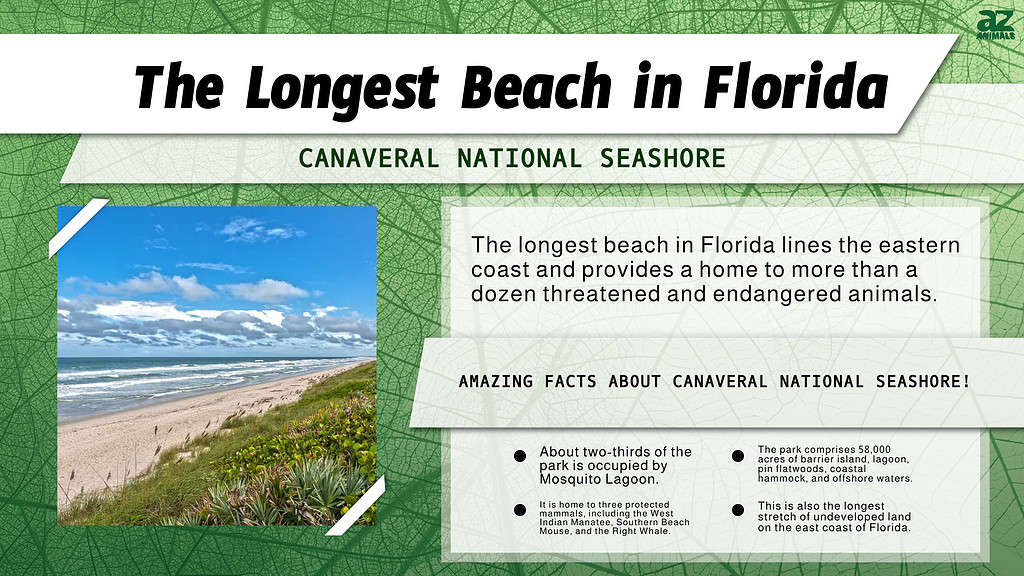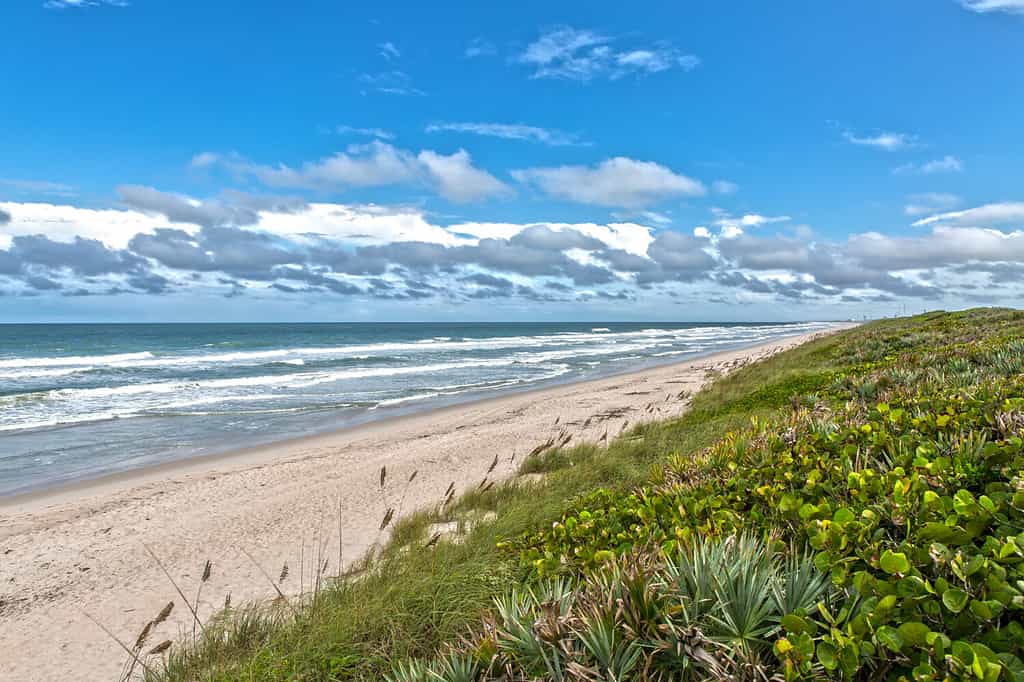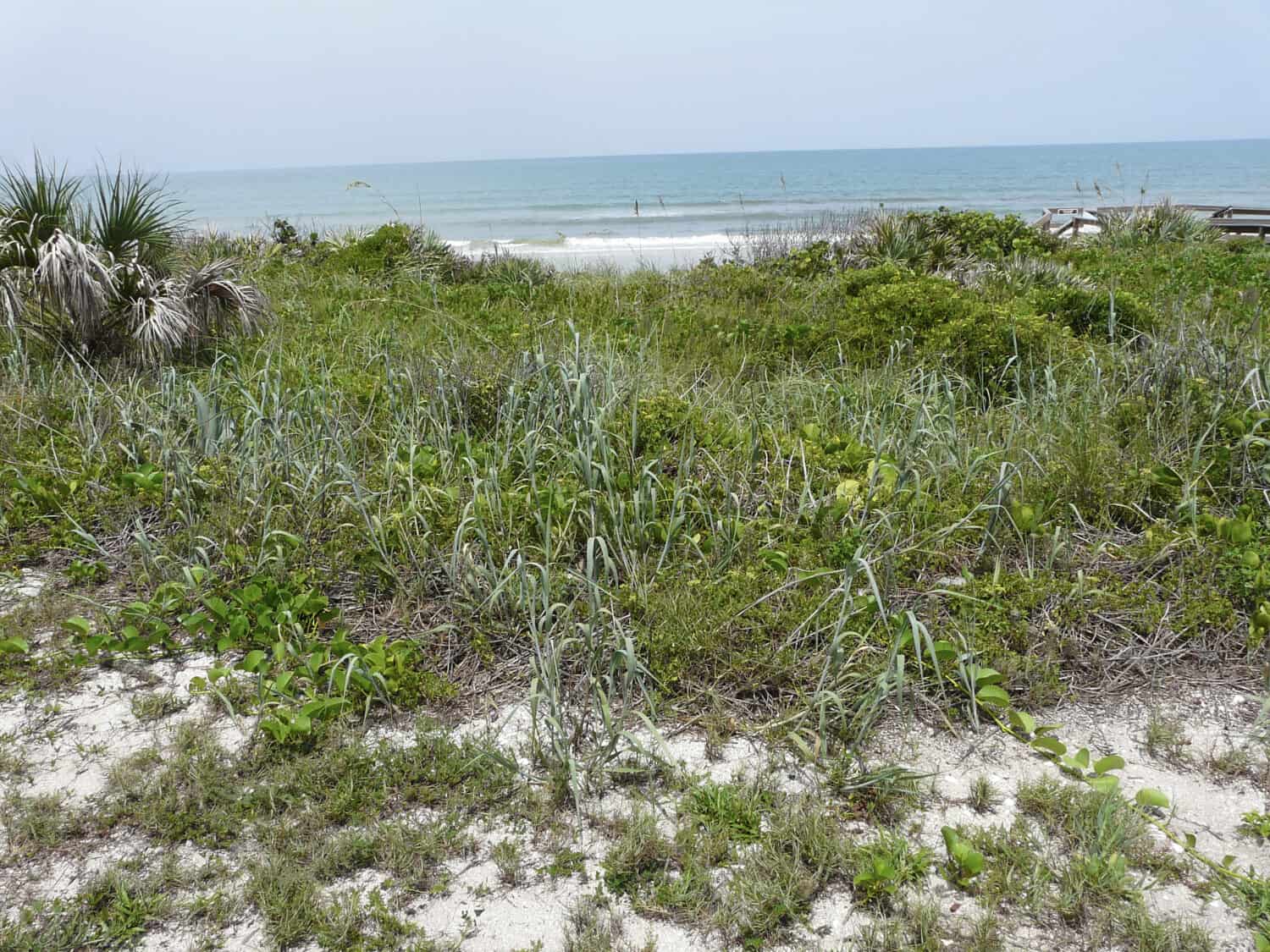Florida is famous for its long stretches of warm, sandy beaches. But which beach is the longest? The longest beach in Florida lines the eastern coast and provides a home to more than a dozen threatened and endangered animals. But that’s not all.

Keep reading to learn more about this perfect beach, the wildlife that calls it home, and its record-breaking archeological site.

The Canaveral National Seashore is the longest beach in Florida.
©Susanne Pommer/Shutterstock.com
What Is the Longest Beach?
The longest beach in Florida is also the longest stretch of undeveloped land on the east coast of Florida. All 24 miles of this paradise belong to the Canaveral National Seashore. Congress created the Canaveral National Seashore at the beginning of 1975 to protect and preserve Florida’s beautiful, wildlife-rich coastline. However, the land has been inhabited for centuries.
The park comprises 58,000 acres of barrier island, lagoon, pin flatwoods, coastal hammock, and offshore waters. It’s also home to threatened and endangered species, providing a safe nesting space for protected turtles. About two-thirds of the park is occupied by Mosquito Lagoon, which is part of the 156-mile-long Indian River Lagoon. There are also artifacts and cultural resources in an area constructed between 800 and 1400 C.E. by some of Florida’s earliest settlements. Turtle Mound is a prehistoric archaeological site where natives left behind the most extensive shell midden in the United States. In fact, the mound is about 600 feet long and rises 50 feet into the air.
Two main entrances lead to the Canaveral National Seashore. One is through New Smyrna Beach on the north end, and the other on the south end through Titusville and Merritt Island National Wildlife Refuge, one of the best birding spots in the state because of the variety of species visitors can see along the trails.

The Florida scrub-jay is one of 310 bird species living on the Canaveral National Seashore.
©Archaeopteryx Tours/Shutterstock.com
Animals Found on Canaveral National Seashore
The longest beach in Florida is home to a diverse and captivating variety of animals. There are 15 species living on the seashore and its waters that are considered threatened or endangered. In fact, this number makes the Canaveral National Seashore home to the second-largest population of endangered and threatened species in the National Park Service.
The seashore is home to three protected mammals, including the West Indian manatee, southern beach mouse, and the right whale. There are also seven protected reptiles living on the Canaveral National Seashore including the loggerhead sea turtle, Kemp’s ridley sea turtle, Atlantic salt marsh snake, and the eastern indigo snake. Moreover, the five protected birds include the Florida scrub jay, the Arctic peregrin falcon, and the crested caracara. But you can find even more native Floridian wildlife dotting the land along the seashore. Mosquito Lagoon nearby also has an abundance of clams, blue crabs, oysters, and shrimp that can be seen on or near the water.

Dense coastal vegetation lines the Canaveral National Seashore.
©romarti/Shutterstock.com
Plants Found on Canaveral National Seashore
The longest beach in Florida is every botanist’s dream. Over 1,000 plant species are recorded on the beach and the surrounding area. Since the Canaveral National Seashore is along the frost line, temperate and subtropical plants are uniquely combined. However, some species don’t exist further south than the shoreline.
One of the primary plant communities along the longest beach in Florida include sea oats and other herbs. Although the more dense growth is from plants like the sea grape. There are dozens more plants integral to the unique ecosystem of Canaveral National Seashore that conservationists are dedicated to preserving.
The Turtle Mound archeological site is home to eight species of subtropical plants alone. However, some of the eight species disappeared because of intense freezes in the 1980s.
Sand Dunes
The dunes are vital for the barrier island by providing stability against a changing environment. It’s steep toward the ocean and sloped toward the land. Unlike other beaches, the Canaveral National Seashore only has one dune ridge. This dune protects the shore and its plants against the wind and waves. It also provides food and habitat for some protected species on the shore, such as the southeastern beach mouse and eastern indigo snake.
Moreover, the plants growing in the dunes are necessary to keep the sand where it is. Most of the dense plant growth is on the land side of the dune. Sea oats are the main plant species that keep the dune secure. In fact, they have adapted to the environment so they can grow even when buried in the sand. Due to their importance, taking sand oats off the beach in Florida is illegal.
The plants living in the dunes are very fragile. As a result, boardwalks lead visitors from the parking lot to the shore to prevent excess foot traffic. Dune fencing also catches blowing sand and keeps vegetation in place to minimize erosion.

Boardwalks lead visitors to the shore to help protect the fragile dune ecosystems.
©Jesse Kunerth/Shutterstock.com
Visiting Canaveral National Seashore
The Canaveral National Seashore and the surrounding areas offer something for everyone, both on land and in the water.
Go to the Beach
The beaches on the Canaveral National Seashore are mostly undeveloped, and there are limited services, meaning there are no spots for picnics, buying food or water, or showering. However, there are bathrooms, boardwalks, and a lifeguard on duty from the end of May until the beginning of September. Visitors are allowed to surf and can paddle to the island within the boundaries of the seashore. Fishing is also very popular in designated areas.
The most popular beaches in the area are Playalinda Beach, Apollo Beach, and Klondike Beach. It’s important to note that Klondike Beach can only be reached by foot or biking on the paths from the seashore.
Hiking Trails
The longest beach in Florida has several short self-guided trails. Visitors can find shell middens on the Castle Windy Trail and the Turtle Mound Trail. However, only the Turtle Mound Trail offers a view of the ocean and Mosquito Lagoon. If you want to hike through dense vegetation, you can hike down any of the three trails including the Eldora Hammock Trail. Last but not least, following the Cruickshank Trail will lead you to an observation tower where you can look out over the marsh.
A scenic 6-mile self-guided drive along the Black Point Wildlife Drive also exists. The area goes through pine flatwoods and the marsh, providing a great view of the wildlife.
Camping Grounds
Camping is not allowed in the Wildlife Refuge, but there are camping options on designated beach areas in the Apollo District from the beginning of November to mid-April. However, permits are required unless you visit one of the surrounding communities that offer private campgrounds.
Kennedy Space Center
The Kennedy Space Center is a quick drive away from the longest beach in Florida, located on Merritt Island. It’s one of NASA’s 10 field centers and the main launch center for human spaceflight. You may be familiar with famous launches such as the Apollo and Skylab operations. Visitors can learn about the space center and spaceflight by walking through the museum exhibits or sitting down for an out-of-this-world presentation by a veteran NASA astronaut.
The Wizard of Oz Museum
If you’re willing to drive 35 miles south to Cape Canaveral, you can stop by and step foot into the wonders of The Wizard of Oz Museum. The museum offers visitors a look into the iconic film with a collection of more than 2,000 props and items of memorabilia. This private collection spans over 35 years and includes immersive experiences with scenes created from the books.
The photo featured at the top of this post is © Susanne Pommer/Shutterstock.com
Thank you for reading! Have some feedback for us? Contact the AZ Animals editorial team.







